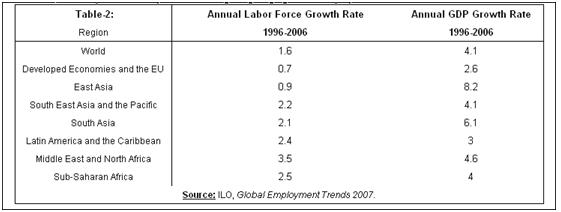Labor Market Influence (supplier)
Description
Labor markets function through the interaction of workers and employers. Traditionally, labor markets have been thought to be perfectly competitive. That is, there are many workers and employers having perfect information and there are no transaction costs. The competitive framework leads to clear conclusions - workers earn their marginal product of labor.
As the supply of human resource, development of labor market is much relevant to development the future office. Align with the growth of population, development of labor market will provide higher education, professional skill and working experience to meet the need of job competition and capable with future office position. Also the globalization trend results the diversification of labor market to support the cross-culture and cross-country cooperation within and outside of the office.
Enablers
- Popularization of compulsory education;
- Lower doorsill of higher education;
- Study and work abroad experience align with the cross-culture and globalization;
- Flexibility of working time and wage;
- Geographical and job mobility;
- Laws and disciplines set up by countries and organizations to protect the labor force.
Inhibitor
- Information asymmetry between demand and supply;
- Mismatch between the skills and other attributes of the labor force and those demanded; by employers;
- Insufficient demand in the overall economy result from economy recession;
- Strike and protest emotion;
- Iniquity competition and bias as disabled, sex ("ice ceiling") and religion;
- Child labor and aging population.
Paradigms
- Keynesian economics
- Neoclassical microeconomics
- The Labour Supply curve
- A Firm's Labour Demand in the Short Run Model
- Equilibrium
- Consumer Services
- Retail Trade (NAICS 44 and 45)
- Accommodation and Food Services (NAICS 72)
Experts
- Peter A. Diamond
- Dale T. Mortensen
- Christopher A. Pissarides
- Orley C. Ashenfelter
- Richard Layard
- Freeman, R.B.
Timing
- According to Statistics Canada’s Labour Force Survey, in Laval, there were nearly 52,000 people working in the consumer services sector for the period from 2003–2005. This accounted for 28.8% of total employment, which was slightly higher than the provincial rate of 27.6%.
- The number of people employed in retail trade grew by an average annual rate of 1.9% in the previous decade (1.8% in Quebec), compared with 1.1% for industries overall. For 2006–2008, employment is expected to grow by 1.7% annually in Laval, compared with 0.9% in Quebec.
- Another sub-sector of consumer services, accommodation and food services, which employed nearly 11,000 workers, has also shown significant growth in recent years. Nearly 90% of the jobs in this sector were concentrated in food services. Sustained employment growth is expected in this sector at an average annual rate of 2.4%, which is higher than the average provincial rate of 1.7%. Just over one in four people in the retail trade sector were employed as salespersons or sales clerks.
- The Labour Force Survey also indicated that in the previous decade, there was a considerable increase in the number of part-time positions, jumping from 18% in 1996 to 35% in 2005. In food services, 50% of workers were employed part time, a slight increase over the previous decade.
Reference
http://en.wikipedia.org/wiki/Labor_market
http://www.law.harvard.edu/programs/lwp/LWPclmp.html
